How do you build an SEO and content strategy that targets intent?
Why is it important to consider search intent?
How do you show the right content to the right audience at the right time in the buyer’s journey?
First, you’ll need to know what search intent is.
(Already know the basics? Jump straight to How To Improve Your Keyword Plan With Search Intent In Mind.)
What Is Search Intent?
Search intent is the purpose behind a user’s search.
Your audience uses search for countless reasons.
Some users Google simple questions. Other users are looking for the right website to purchase goods.
It’s up to you to be on the search engine results pages (SERPs) at the right time for each type of search.
The Four Main Types Of Search Intent
Knowing what people are searching for helps you create the right type of content, giving you a higher chance to meet your goals.
Because people search for millions of queries with dozens of goals in mind, it’s easier to categorize these searches into search intent.
To make sense of what people are searching for, you can organize their keywords into these four main types:
- Informational: searches that are for an answer to a specific question or information to learn about a topic.
- Navigational: searches that are looking for a specific site, page on the web, or geographic location.
- Commercial: searches that are investigating or comparing brands, products, or services.
- Transactional: searches that indicate the intent to complete a purchase or take action on a website.
By understanding these labels, paired with other keyword metrics like search volume, CPC, and difficulty, you and your team will be able to create and serve better content at the right times.
But what does search intent actually look like?
How can you identify these qualities in your keywords and use this information to perform intent-targeted SEO and content planning?
Spoiler: it can be a lot easier with an intent tool like Semrush!
How To Identify A Keyword’s Intent
To understand a keyword’s intent, you can look for clues.
Clues can be found:
- On the SERP.
- In the keyword phrase itself.
- With a keyword intent tool.
How To Identify Intent With SERP Clues
Google is really good at recognizing intent. It serves up SERPs to fit what it deems to be the intent behind every keyword.
So, you just need to look at what Google provides on the SERP to help you decode the intent.
If you see:
- Shopping ads, the intent is Transactional.
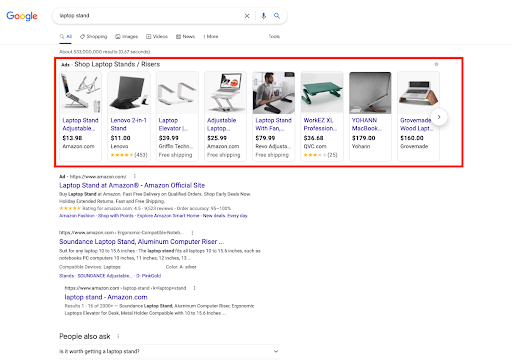 Screenshot from search for [laptop stand], Google, November 2021
Screenshot from search for [laptop stand], Google, November 2021- Reviews, the intent is Commercial.
Commercial searches often feature Google Shopping ads as well.
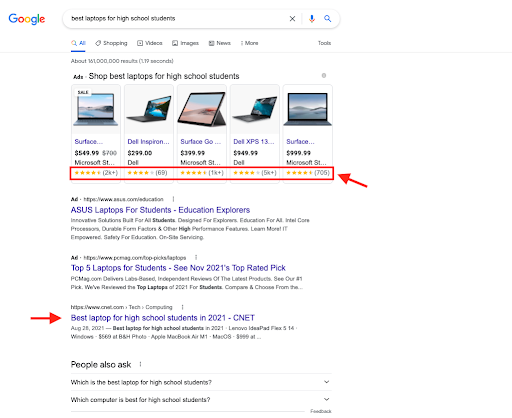 Screenshot from search for [best laptops for high school students], Google, November 2021
Screenshot from search for [best laptops for high school students], Google, November 2021- Instant Answer, People Also Ask & Knowledge Panel, the intent is Informational.
For informational searches, Google likes to provide info cards and related questions to explore the topic.
 Screenshot from search for [what is cryptocurrency], Google, November 2021
Screenshot from search for [what is cryptocurrency], Google, November 2021- Site links on the top branded result, the intent is Navigational.
If the search is a brand name and the top organic result on the SERP has that brand listed with a lot of site links, this is an indicator of navigational intent.
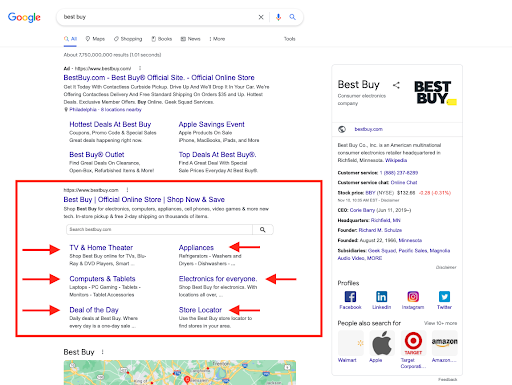 Screenshot from search for [best buy], Google, November 2021
Screenshot from search for [best buy], Google, November 2021How To Identify Intent With Keyword Clues
The next place you can look to manually identify intent is within the keyword phrase itself.
If certain words are included in a query, you can start to assume what the intent might be.
Keyword clue examples for each search intent type are:
- Transactional: buy, cheap, for sale online.
- Commercial: best, review, comparison.
- Navigational: any brand name.
- Informational: how, why, what, tutorial.
How To Identify Intent With Semrush’s Keyword Intent Solution
The last and quickest way to identify a keyword’s intent is with a tool that is designed to analyze SERPs and the language behind keywords.
Semrush does this automatically.
Any time you research a keyword in Semrush’s suite, you’ll see an intent label.
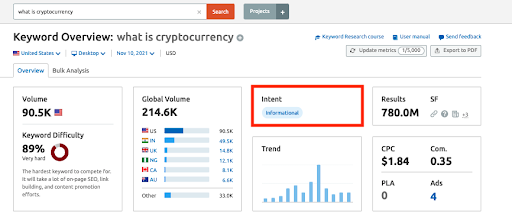 Screenshot from Semrush.com, November 2021
Screenshot from Semrush.com, November 2021In early November, we saw SEO professionals take to Twitter to share their excitement as this feature was released.
 Screenshots from Twitter.com, November 2021
Screenshots from Twitter.com, November 2021So, once you know how to identify a keyword’s intent, what’s next?
Once you identify a keyword’s intent, you can then decide on the type of content to create for your site to best target the keyword.
How To Create Content Using Keyword Intent
How Do I Rank Well For Informational Keywords?
Provide information-rich content that answers questions, provides facts, and offers help.
How Do I Create Content For Commercial Keywords?
Stay away from just targeting product pages. Try writing a comparison article instead.
If your keyword phrase is [best laptops for high school students], target this organic traffic with a comparison article that offers information about the options people should consider for laptops for high school students.
How Do I Create Content For Transactional Keywords?
With transactional searches, you should make your product page as clean and direct as possible.
Offer information on your product/service that makes it easy for people to decide to purchase or take action from the page.
 Screenshot from Semrush.com, November 2021
Screenshot from Semrush.com, November 2021Ready to make it all work together?
How To Build Your Keyword Plan With Search Intent In Mind
Just knowing how to build out your content with search intent in mind will elevate you to a new level of success. You may begin to rank higher on SERPs and find your content on page one.
Take it a step further. Outrank your competition by researching and discovering their intent.
Maybe your competitors are ranking for a lot of keywords that are informational while your site only targets navigational and commercial queries.
If you want to outrank them, you’ll need to pivot your content strategy to target informational queries as well.
Tip #1: Add Search Intent To Your Competitor Research
If you have an SEO tool that gathers organic keyword data:
- Look at your competitors’ keyword list.
- Cross-reference each individual keyword, using the keyword intent clues listed above.
- Manually notate what type of intent each keyword is.
- Map each keyword to each of your competitions’ high-ranking pages.
- Analyze the data. Is their homepage ranking for navigational queries? Are their top blog posts ranking for informational or commercial searches? What are your pages doing in comparison?
An Easier Way:
Semrush’s new intent metric tool makes it very easy to dive into this data.
All you have to do is:
- Enter any domain into the main search to get a Domain Overview report.
(This will include organic search traffic at an overview and in that overview, displays the full ratio of intent that this site ranks for.)
Examples
Let’s look at three competing home improvement blogs and compare their organic keyword intent ratios.
Remodelaholic.com has a high ratio of informational keywords, followed by a small percentage of navigational, and the last quarter is a combo of commercial and transactional keywords:
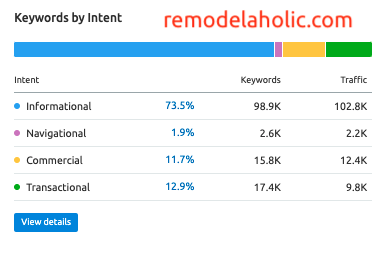 Screenshot from Semrush.com, November 2021
Screenshot from Semrush.com, November 2021Shanty-2-chic.com has a similar order of ratio, but a higher amount of transactional keywords compared to commercial keywords:
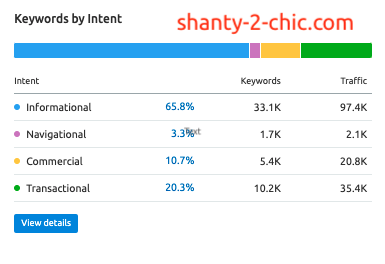 Screenshot from Semrush.com, November 2021
Screenshot from Semrush.com, November 2021Ana-white.com has a very similar-looking profile to shanty-2-chic in terms of the intent ratios, but with a higher total number of keywords:
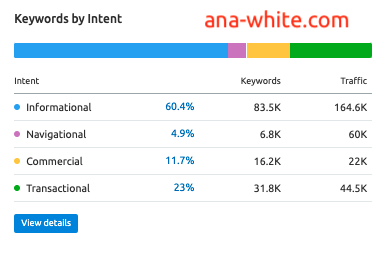 Screenshot from Semrush.com, November 2021
Screenshot from Semrush.com, November 2021What can you do with this information?
Analyze & Plan: If you are trying to break into this example’s niche, it’s a good idea to build your target keyword list to be heavy on informational keywords, followed by a mix of commercial and transactional.
After you have some competitive insights, you can build out a keyword plan.
In our example, we discovered that the competitors in your niche were getting most of their traffic from informational keywords.
You could consider doing the same. Look for low-competition, informational searches your site could target.
Maybe in your real-life scenario, you’ve discovered that one competitor has high rankings for a lot of commercial terms that no one else was targeting. If so, try competing for those.
Tip #2: Discover Keywords & Long-Tail Phrases With The Right Intent
By discovering and including a mix of proper intent keywords and phrases in your strategy, plan, and briefs, you can give Google a clear understanding of your intent.
How To Discover & Implement Informational Phrases:
- Google your target keyword and look for “People Also Ask” segments within the SERP.
- Add these related questions to your informational content strategy.
 Screenshot from search for [2×4 shelving], Google, November 2021
Screenshot from search for [2×4 shelving], Google, November 2021How To Discover & Implement Transactional Phrases:
- Experiment by adding modifiers like [buy], [cheap], or [for sale online] to your target keywords, and look at the results page.
- If the SERP shows ads and signs of transactional intent from the beginning of this article, you’ll know the keyword phrase has transactional intent.
 Screenshot from search for [buy cheap 2×4 shelving], Google, November 2021
Screenshot from search for [buy cheap 2×4 shelving], Google, November 2021How To Discover & Implement Commercial Phrases:
- Experiment by adding modifiers like [best] or [comparison] to your target keywords, and look at the results page.
- If the SERP shows ads and the signs of commercial intent from the beginning of this article, you’ll know the keyword phrase has commercial intent.
Answerthepublic.com is another free way to manually research intent.
- Enter a target keyword.
- Analyze the “mind map” of expanded search queries based on common question words like “where,” “how,” and “why.”
- Cross-reference these questions with our guide above and check their SERPs in Google.
 Screenshot from AnswerThePublic, November 2021
Screenshot from AnswerThePublic, November 2021An Easier Way: Use Semrush To Instantly Find Keywords By Intent
If you have an account with Semrush, this whole process is a lot easier.
All you have to do is:
- Go to the Keyword Magic Tool and enter your target keyword. Everything that appears in the resulting table will be labeled with intent.
 Screenshot from Semrush.com, November 2021
Screenshot from Semrush.com, November 2021Bonus: You can also filter this report to hone in on individual or multiple types of intent quickly. Look in the keyword difficulty column as well to keep an eye out for low-competition keywords.
This process can be repeated as many times as you need in order to build your perfect keyword list.
For example, the query [2×4 shelving] did not offer any related commercial intent keywords, but if we change the query to [diy shelving] we can see some related commercial and transactional keywords to target.
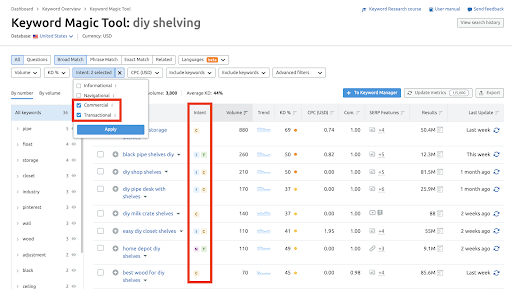 Screenshot from Semrush, November 2021
Screenshot from Semrush, November 2021Take all of the keywords you’re interested in and save them to your list.
How will you use intent in your SEO workflow?
If you’d like to try out Semrush’s solution, you can sign up for free anytime on our website!
The opinions expressed in this article are the sponsor's own.



